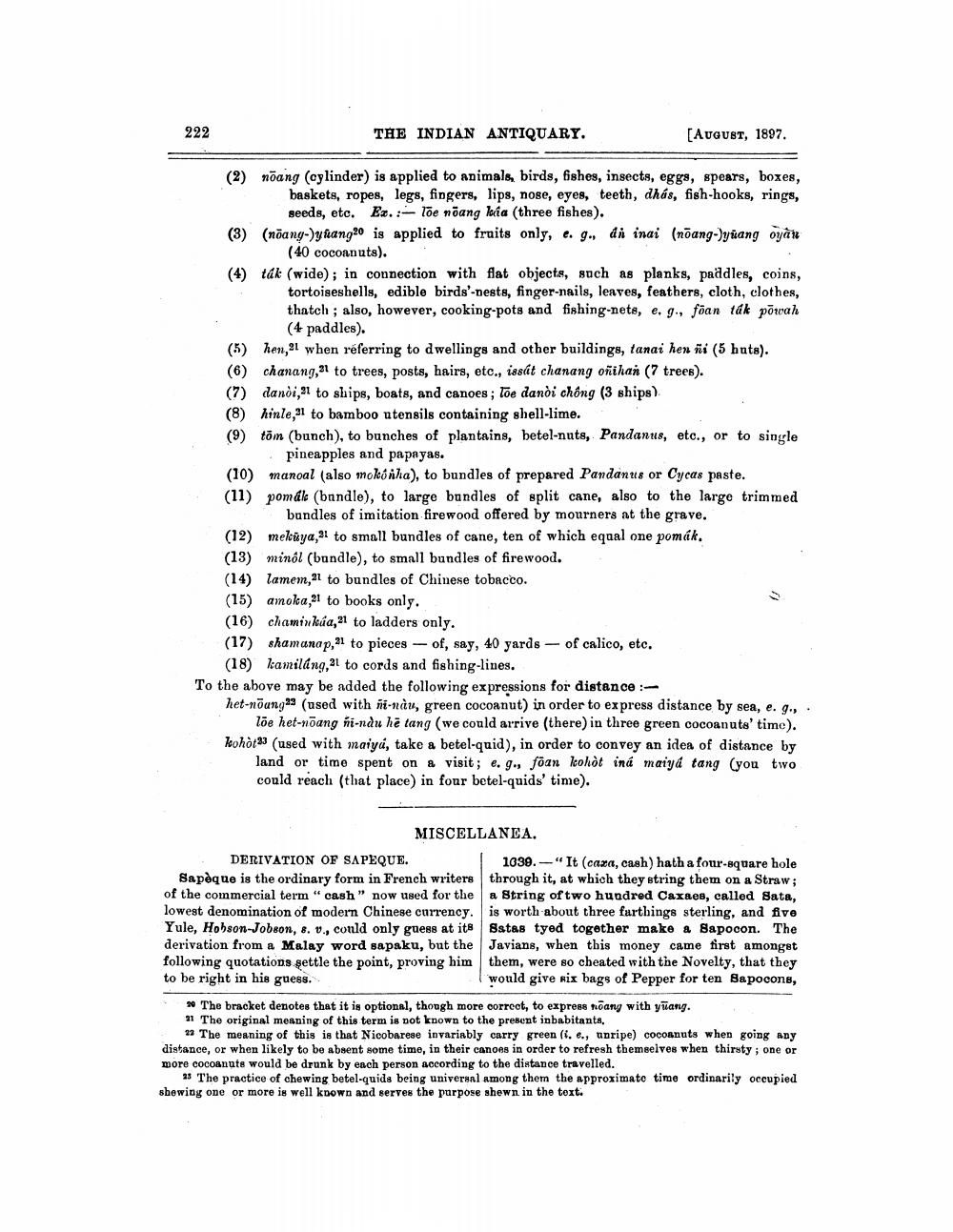________________
222
THE INDIAN ANTIQUARY.
[AUGUST, 1897.
(2) noang (cylinder) is applied to animals, birds, fishes, insects, eggs, spears, boxes, baskets, ropes, legs, fingers, lips, nose, eyes, teeth, dhús, fish-hooks, rings, seeds, etc. Ex.:- Toe noang kaa (three fishes).
(3) (noang-)yang20 is applied to fruits only, e. g., di inai (noang-)yuang oyau (40 cocoanuts).
(4) ták (wide); in connection with flat objects, such as planks, paddles, coins, tortoiseshells, edible birds'-nests, finger-nails, leaves, feathers, cloth, clothes, thatch; also, however, cooking-pots and fishing-nets, e. g., föan tak pōwah (4 paddles).
(5) hen,21 when referring to dwellings and other buildings, tanai hen ni (5 huts). (6) chanang, to trees, posts, hairs, etc., issát chanang oñihan (7 trees).
(?) danòi,31 to ships, boats, and canoes ; Toe danòi chồng (3 ships).
(8) hinle,31 to bamboo utensils containing shell-lime.
(9) tom (bunch), to bunches of plantains, betel-nuts, Pandanus, etc., or to single pineapples and papayas.
(10) manoal (also mokonha), to bundles of prepared Pandanus or Cycas paste.
(11) pomak (bundle), to large bundles of split cane, also to the large trimmed bundles of imitation firewood offered by mourners at the grave.
(12) mekuya, to small bundles of cane, ten of which equal one pomák.
(13) minél (bundle), to small bundles of firewood.
(14) lamem, to bundles of Chinese tobacco.
(15) amoka,21 to books only.
(16) chaminkaa,21 to ladders only.
(17) shamanap,21 to pieces of, say, 40 yards (18) kamiláng, to cords and fishing-lines.
To the above may be added the following expressions for distance :
:
het-noang (used with ñi-nàu, green cocoanut) in order to express distance by sea, e. g., . loe het-noang ni-ndu he tang (we could arrive (there) in three green cocoanuts' time). kohot23 (used with maiyá, take a betel-quid), in order to convey an idea of distance by land or time spent on a visit; e. g., föan kohot iná maiyá tang (you two could reach (that place) in four betel-quids' time).
MISCELLANEA.
of calico, etc.
DERIVATION OF SAPEQUE.
Sapèque is the ordinary form in French writers of the commercial term "cash" now used for the lowest denomination of modern Chinese currency. Yule, Hobson-Jobson, s. v., could only guess at its derivation from a Malay word sapaku, but the following quotations settle the point, proving him to be right in his guess.
1039."It (caza, cash) hath a four-square hole through it, at which they string them on a Straw; a String of two hundred Caxaes, called Sata, is worth about three farthings sterling, and five Sstas tyed together make a Sapocon. The Javians, when this money came first amongst them, were so cheated with the Novelty, that they would give six bags of Pepper for ten Sapocons,
20 The bracket denotes that it is optional, though more correct, to express noang with yuang.
21 The original meaning of this term is not known to the present inbabitants,
22 The meaning of this is that Nicobarese invariably carry green (i. e., unripe) cocoanuts when going any distance, or when likely to be absent some time, in their canoes in order to refresh themselves when thirsty; one or more cocoanuts would be drunk by each person according to the distance travelled.
25 The practice of chewing betel-quids being universal among them the approximate time ordinarily occupied shewing one or more is well known and serves the purpose shewn in the text.




